
The Edmund Fitzgerald

Edmund Fitzgerald Blueprint
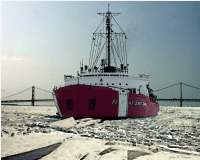
The Mac
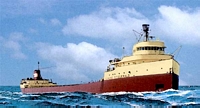
The Edmund Fitzgerald

The Fitz and the wave
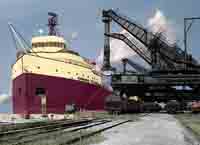
Loading the Edmund Fitz
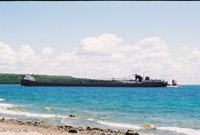
Round Island Passage
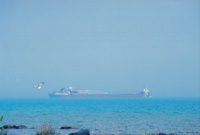
Presque Isle Solitude

The Morrow
 The Edmund Fitzgerald |
 Edmund Fitzgerald Blueprint |
 The Mac |
||||||||||||||||||
 The Edmund Fitzgerald |
 The Fitz and the wave |
 Loading the Edmund Fitz |
||||||||||||||||||
 Round Island Passage |
 Presque Isle Solitude |
 The Morrow |
She was launched into this world with a splash so big that one of the guests viewing the side launch became so excited that he had a heart attack - right on the spot. Named for a Milwaukee banker, she was destined to leave her mark on Great Lakes Shipping for many years to come and die in such a way as to leave a mystery just as big as her gigantic size.
Owned by Northwestern Mutual Life Insurance, she sailed under the Columbia Transportation Company flag. At 729 feet long, 75 feet wide, 39 feet deep, and 8,686 tons in dry weight, she was the largest laker of her day and set record upon record, from the day she entered into service until her untimely sinking. She set records for the most ore carried in one load; the most ore carried through the Soo Locks; and the most ore carried in one season - she did this without interruption year after year. She could carry upwards of 25,000 tons of ore in her holds.
She was the flagship of the Columbia Line and was known as the queen of their fleet. Her accommodations were impeccable. She had a pair of luxury staterooms for guests that rivaled ocean liner suites of her day. Her outside coloring was such that the multitude of ship watchers could not be mistaken as to which ship they were viewing.
Although harsh conditions are encountered on the Great Lakes each fall and winter, every vessel must make that final trip of the season and the “Big Fitz” was no exception. On Sunday, November 9 1975 the Fitzgerald left Superior, Wisconsin loaded with over 26,000 tons of iron ore heading for Detroit’s steel hungry auto plants. The trip started on a warm and sunny autumn day, however, the weather and conditions were soon to change.
Lake Superior's 400 mile length and its lack of natural wave barriers give the wind plenty of room to generate waves up to 40 feet in height. By Monday, the third day of the Fitzgerald's last voyage, the weather had deteriorated to the point that the Fitzgerald was awash a good deal of the time. With waves washing over her decks and the ship's radar system out, Captain McSorley of the Fitzgerald radioed to the nearby lake freighter Arthur Anderson to shadow him. McSorley was worried because the Fitzgerald was taking on water and had developed a slight list. With his keen eye on the Fitzgerald, Captain J. Barney Cooper of the Arthur Anderson noticed that the Edmund Fitzgerald may have passed too close to Lake Superior's Caribou Island. He wondered if the "Big Fitz" might have hit bottom near the island, known for its shallow shoals and protruding rocks.
It was a few minutes after 7:00 PM on Monday, November 10 1975. Although Captain Cooper noticed a pair of ships waiting in Whitefish Bay, he could no longer see the Edmund Fitzgerald ahead of him. Unable to reach the “Big Fitz” by radio, he informed the Coast Guard that the Edmund Fitzgerald had probably gone down.
This started the most comprehensive investigation into a shipping disaster in U.S. Coast Guard history. Although the Coast Guard determined that the locks on the ship's hatch covers were improperly installed, it seems that no one but the Coast Guard believed this to be the cause of her sinking. Hatch covers, grounding, a rouge wave - many theories abound to the cause of her sinking. The remains of the Edmund Fitzgerald, the most famous ship to ply the waters of the Great Lakes, lie at the bottom of Lake Superior, not far from Whitefish Point, Michigan.